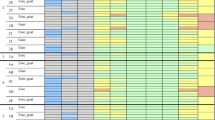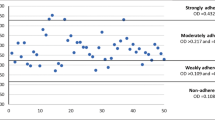Abstract
The objective of this work was to evaluate the microbiological quality of cheese produced by formal and informal micro-enterprises in Paipa, Colombia, to isolate potentially pathogenic bacteria and to determine their prevalence and resistance to antimicrobials such as antibiotics and biocides. Sixteen micro-enterprises of the seventy existing in the region were sampled during 3 years. Viable concentrations of aerobic mesophiles, total and fecal coliforms, Salmonella sp., Listeria monocytogenes, Staphylococcus sp., yeasts, and molds were determined. Seventy-three bacterial isolates were identified by 16S rRNA gene sequencing. The susceptibility of the isolates to antibiotics and biocides was determined. The results indicated that between 98 and 100% of the cheese samples (n = 48 samples) of formal and informal micro-enterprises presented populations of total and fecal coliforms and Staphylococcus sp. above the limits established by Colombian regulations and varied according to the micro-enterprise. The results also indicated that 56% of Staphylococcus isolates were S. aureus. L. monocytogenes was positive in 38% of the samples. Salmonella sp. was not detected. The coliforms that prevailed were Escherichia coli (25%), Citrobacter freundii (14%), and Proteus mirabilis (8%). All L. monocytogenes were sensitive to ampicillin but resistant to erythromycin and trimethoprim-sulfamethoxazole. S. aureus isolates were susceptible to most antibiotics, except tetracycline and erythromycin (7% resistance). Likewise, 30% of coliforms (n = 36) were multidrug-resistant to antibiotics but susceptible to biocides.

Similar content being viewed by others
References
World Health Organization (2020) Inocuidad de los alimentos. https://www.who.int/es/news-room/fact-sheets/detail/food-safety. Accessed 2 June 2019
Instituto Nacional de Salud de Colombia (2019) Sistema Nacional de Vigilancia en Salud Pública. https://www.medellin.gov.co/irj/go/km/docs/pccdesign/medellin/Temas/Salud_0/Publicaciones/Shared%20Content/BoletinEpidemiologico/2019/5-Boletin%205%20ETAS-Final.pdf. Accessed 19 December 2019
CONtextoganadero (2013) Colombia, a la vanguardia en producción de quesos: informe. http://www.contextoganadero.com/ganaderia-sostenible/colombia-la-vanguardia-en-produccion-de-quesos-informe. Accessed 21 June 2020
Robayo AM, Pachón FA (2013) Characterization of Paipa and campesino cheeses chain in the framework of programa mercados campesinos: two cases study. Rev Med Vet Zoot 63:196–212
Noguera N (2013) El origen del queso Paipa, un producto que se abre paso en el mercado https://www.eltiempo.com/archivo/documento/CMS-12802666. Accessed 21 June 2020
Superintendencia de Industria y Comercio de Colombia. Resolución 0070–802. (2011) Por la cual se concede la protección con denominación de origen al queso Paipa. Bogotá, D.C. Colombia. https://www.sic.gov.co/sites/default/files/files/Denominacion%20de%20Origen/Agro%20-%20Alimenticios/Queso%20Paipa/queso_paipa.pdf. Accessed 4 February 2021
Zhu Q, Gooneratne R, Hussain M (2017) Listeria monocytogenes in fresh produce: outbreaks, prevalence and contamination levels. Foods 6(3):21. https://doi.org/10.3390/foods6030021
Melo J, Andrew PW, Faleiro ML (2015) Listeria monocytogenes in cheese and the dairy environment remains a food safety challenge: the role of stress responses. Food Res Int 67:75–90. https://doi.org/10.1016/j.foodres.2014.10.031
Vasek OM, Mazza SM, de Giori GS (2013) Physicochemical and microbiological evaluation of corrientes artisanal cheese during ripening. Food Sci Technol 33:151–160. https://doi.org/10.1590/s0101-20612013005000021
Masiello SN, Martin NH, Trmčić A, Wiedmann M, Boor KJ (2015) Identification and characterization of psychrotolerant coliform bacteria isolated from pasteurized fluid milk. J Dairy Sci 99:130–140. https://doi.org/10.3168/jds.2015-9728
World Health Organization (2018) High levels of antibiotic resistance found worldwide, new data shows. https://www.who.int/mediacentre/news/releases/2018/antibiotic-resistance-found/en/. Accessed 23 April 2018
O'Neill, J. (2014) Review on antimicrobial resistance antimicrobial resistance: tackling a crisis for the health and wealth of nations. London: Review on Antimicrobial Resistance. https://amr-review.org/sites/default/files/AMR%20Review%20Paper%20-%20Tackling%20a%20crisis%20for%20the%20health%20and%20wealth%20of%20nations_1.pdf Accessed 2 June 2019
de Kraker MEA, Stewardson AJ, Harbarth S (2016) Will 10 million people die a year due to antimicrobial resistance by 2050? PLoS Med 13(11):e1002184. https://doi.org/10.1371/journal.pmed.1002184
Romero JL, Grande Burgos MJ, Pérez-Pulido R, Gálvez A, Lucas R (2017) Resistance to antibiotics, biocides, preservatives and metals in bacteria isolated from seafoods: Co-selection of strains resistant or tolerant to different classes of compounds. Front Microbiol 8:1650. https://doi.org/10.3389/fmicb.2017.01650
Wesgate R, Grasha P, Maillard J-Y (2016) Use of a predictive protocol to measure the antimicrobial resistance risks associated with biocidal product usage. Am J Infect Control 44(4):458–464. https://doi.org/10.1016/j.ajic.2015.11.009
European Parliament and Council (2012) Regulation (EU) No 528/2012 of the European Parliament and of the Council of 22 May 2012 concerning the making available on the market and use of biocidal products. Official Journal of the European Union, L 167, 1–123. Available online: http://eur-lex.europa.eu/LexUriServ/LexUriServ.do?uri=OJ:L:2012:167:FULL:EN:PDF. Accessed 2 June 2019
Neira E, De Silvestri SJA (2006) Milking process and sanitary quality analysis of milk used in Paipa cheese production in Paipa, Boyacá, Colombia. Revista de Investigación 6: 163–170. https://www.redalyc.org/pdf/952/95260203.pdf. Accessed 25 May 2021
FAO/WHO [Food and Agriculture Organization of the United Nations/World Health Organization] (2016) Statistical aspects of microbiological criteria related to foods. A risk managers guide. Microbiological risk assessment series, no 24. World Health Organization, Rome. https://www.who.int/foodsafety/publications/mra_24/en/. Accessed 25 May 2021
International Organization for Standardization (2013) ISO 4833–1:2013 E microbiology of the food chain. Horizontal method for the enumeration of microorganisms — part 1: colony count at 30 degrees C by the pour plate technique. International Organization for Standardization. Geneva, Switzerland. https://www.iso.org/standard/53728.html. Accessed 25 May 2021
International Organization for Standardization (1999) ISO 6888–1:1999 microbiology of food and animal feeding stuffs. Horizontal method for the enumeration of coagulase-positive staphylococci (Staphylococcus aureus and other species). International Organization for Standardization. Geneva, Switzerland. https://www.iso.org/standard/23036.html. Accessed 25 May 2021
American Public Health Association (APHA) American Water Works Association (AWWA), Water Environment Federation (WEF) (2012) Standard methods for the examination of water and wastewater, 22 edn. Rice EW, Baird RB, Eaton AD, Clesceri LS (eds) APHA, AWWA, WEF, United States, pp 9–66–9–72
International Organization for Standardization (2017) ISO 6579–1:2017E microbiology of food and animal feeding stuffs. Horizontal method for the detection of Salmonella spp. International Organi-zation for Standardization. Geneva, Switzerland. https://www.sis.se/api/document/preview/921516/. Accessed 25 May 2021
International Organization for Standardization. (2017) ISO 11290–1. 2017E microbiology of the food chain. Horizontal method for the detection and enumeration of Listeria monocytogenes and Listeria spp. https://www.sis.se/api/document/preview/921869/. Accessed 25 September 2017
Xtrem biotech (2019). Extraction of DNA. http://www.xtrembiotech.com/en/. Accessed 2 May 2019
Quigley LO, O’Sullivan TP, Beresford R, Ross P, Fitzgerald GF, Cotter PDA (2012) Comparison of methods used to extract bacterial DNA from raw milk and raw milk cheese. J Appl Microbiol 113:96–105. https://doi.org/10.1111/j.1365-2672.2012.05294.x
Hall T (2011) BioEdit: an important software for molecular biology software review. GERF Bullet Biosci 2:60–61
Clinical and Laboratory Standards Institute (CLSI) (2019) Performance standards for antimicrobial susceptibility testing CLSI supplement M100S. 29th edn. Wayne, PA, USA. http://em100.edaptivedocs.net/GetDoc.aspx?doc=CLSI%20M100%20ED29:2019&scope=user Accessed 23 June 2019
European Committee on Antimicrobial Susceptibility Testing (EUCAST) (2021) Breakpoint tables for interpretation of MICs and zone diameters. Version 11.0, valid from 2021–01–01. https://www.eucast.org/fileadmin/src/media/PDFs/EUCAST_files/Breakpoint_tables/v_11.0_Breakpoint_Tables.pdf Accessed 14 April 2021
Instituto Colombiano de Normas Técnicas (ICONTEC) (2000) Norma Técnica Colombiana (NTC) 750 Productos lácteos: quesos https://es.scribd.com/doc/145758324/NTC-750-Queso Accessed 23 April 2018
Elbagory AM, Hammad AM, Alzahraa Alzahraa Shiha MA (2016) Prevalence of coliforms, antibiotic resistant coliforms and E. coli serotypes in raw milk and some varieties of raw milk cheese in Egypt. Nutr Food Technol 2(1). https://doi.org/10.16966/2470-6086.114
Chaves-López C, De Angelis M, Martuscelli M, Serio A, Paparella A, Suzzi G (2006) Characterization of the Enterobacteriaceae isolated from an artisanal Italian ewe’s cheese (Pecorino Abruzzese). J Appl Microbiol 101:353–360. https://doi.org/10.1111/j.1365-2672.2006.02941.x
Fratamico PM, DebRoy C, Liu Y, Needleman DS, Baranzoni GM, Feng P (2016) Advances in molecular seroty** and subty** of Escherichia coli. Front Microbiol 12:1–8. https://doi.org/10.3389/fmicb.2016.00644
Dhanashekar R, Akkinepalli S, Nellutla A (2012) Milk-borne infections. An analysis of their potential effect on the milk industry. GERMS 2:101–109. https://doi.org/10.11599/germs.2012.1020
Fisher EL, Otto M, Cheung GYC (2018) Basis of virulence in enterotoxin-mediated staphylococcal food poisoning. Front Microbiol 9:436. https://doi.org/10.3389/fmicb.2018.00436
Argemi X, Hansmann Y, Prola K, Prévost G (2019) Coagulase-negative staphylococci pathogenomics. Int J Mol Sci 20:1215. https://doi.org/10.3390/ijms20051215
Ocampo ID, González C, Moreno SL, Calderón C, Flórez-Elvira LJ, Olaya MB, Lesmes MC (2019) Presence of Listeria monocytogenes in fresh artisanal cheese marketed in Cali-Colombia. Acta Agron 68(2):108–114. https://doi.org/10.15446/acag.v68n2.77185
Muñoz AI, Vargas M, Otero L, Díaz V (2012) Presencia de Listeria monocytogenes en alimentos listos para el consumo, procedentes de plazas de mercado y delicatessen de supermercados de cadena, Bogotá, D.C., 2002–2008. Biomedica 31:428–439. https://doi.org/10.7705/biomedica.v31i3.39425
Gallegos J, Arrieta G, Máttar S, Poutou R, Trespalacios A, Carrascal A (2007) Frecuencia de Listeria spp., en quesos colombianos costeños. Rev MVZ Córdoba 12:996–1012
Fadul L, Quecano M. (2005). Evaluation of the microbial flora of Paipa cheese during different ripening periods. Thesis degree of Zootechnist. Universidad de la Salle. Bogotá, D.C. Colombia. https://ciencia.lasalle.edu.co/cgi/viewcontent.cgi?article=1174&context=zootecnia. Accessed 30 April 2019
Casellas JM (2011) Resistencia a los antibacterianos en América Latina: consecuencias para la infectología. Rev Panam Salud Pública 30(6):519–528
Tekiner İH, Özpınar H (2016) Occurrence and characteristics of extended spectrum beta-lactamases-producing Enterobacteriaceae from foods of animal origin. Braz J Microbiol 47:444–451. https://doi.org/10.1016/j.bjm.2015.11.034
Lynch JP, Clark NM, Zhanel GG (2013) Evolution of antimicrobial resistance among Enterobacteriaceae (focus on extended spectrum β-lactamases and carbapenemases). Expert Opin Pharmaco 14:199–210
Kananori H, Yano H, Hirakata Y, Endo S, Arai K, Ogawa M, Shimojima M, Aoyagi T, Hatta M, Yamada M, Nishimaki K, Kitagawa M, Kunishima H, Kaku M (2011) High prevalence of extended-spectrum β-lactamases and qnr determinants in Citrobacter species from Japan: dissemination of CTX-M-2. J Antimicrob Chemother 66:2255–2262. https://doi.org/10.1093/jac/dkr283
Yao, Y, Imirzalioglu C, Hain T, Kaase M, Gatermann S, Exner M, Mielke M, Hauri A, Dragneva Y, Bill R, Wendt C, Wirtz A, Domann E, Chakraborty T (2014) Complete nucleotide sequence of a Citrobacter freundii plasmid carrying KPC-2 in a unique genetic environment. Genome Announc 2(6):e01157-14. https://doi.org/10.1128/genomeA.01157-14
Gadea R, Fernández Fuentes MA, Pérez Pulido R, Gálvez A, Ortega E (2016) Adaptive tolerance to phenolic biocides in bacteria from organic foods: effects on antimicrobial susceptibility and tolerance to physical stresses. Food Res Int 85:131–143
Acknowledgements
The authors thank Paipa Cheese Association (ASOQUESOPAIPA), Rocio Milena Buitrago, and Jaqueline Galvis.
Funding
Universidad de Jaén (AGR-230), Universidad de Boyacá, and Asociación Universitaria Iberoamericana de Postgrado (AUIP) provided financial support for this research.
Author information
Authors and Affiliations
Contributions
José Castellanos-Rozo wrote the article and performed counting, isolation, and test antibiotics, Maria José Grande helped with test of biocides. Antonio Gálvez, Rubén Pérez and Rosario Lucas contributed to the design and supervision of experimental work and revised the article.
Corresponding author
Ethics declarations
Conflict of interest
The authors declare no competing interests.
Additional information
Responsible Editor: Luis Augusto Nero
Publisher's note
Springer Nature remains neutral with regard to jurisdictional claims in published maps and institutional affiliations.
Rights and permissions
About this article
Cite this article
Castellanos-Rozo, J., Pérez Pulido, R., Grande, M. et al. Potentially pathogenic bacteria isolated from Paipa cheese and its susceptibility profiles to antibiotics and biocides. Braz J Microbiol 52, 1535–1543 (2021). https://doi.org/10.1007/s42770-021-00522-2
Received:
Accepted:
Published:
Issue Date:
DOI: https://doi.org/10.1007/s42770-021-00522-2




